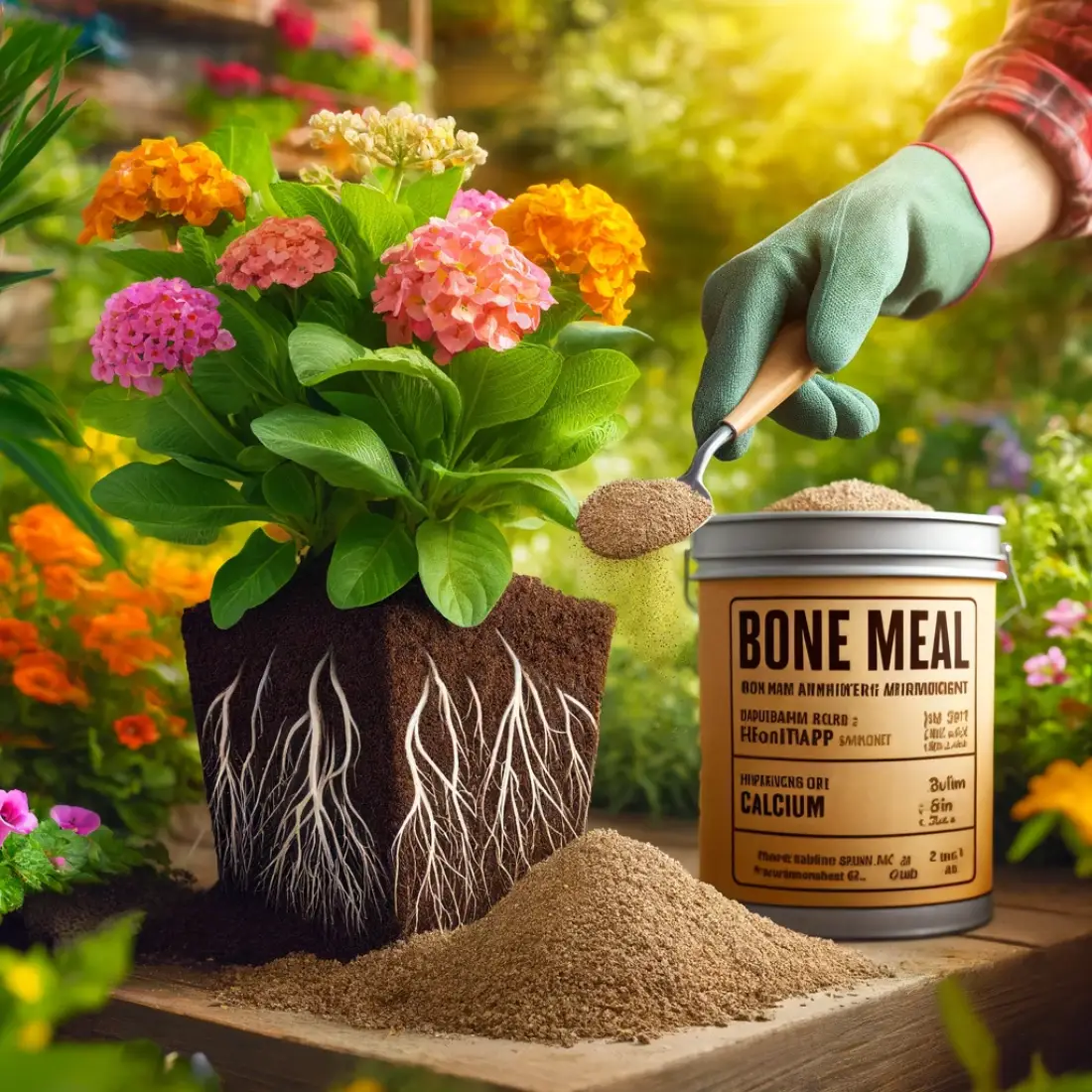Bone meal is a nutrient-rich organic fertilizer made from finely ground animal bones, primarily from the meat industry. This natural amendment is valued for its high phosphorus and calcium content, essential nutrients that support robust plant growth.
- Bone meal is a valuable organic fertilizer.
- Provides essential nutrients like phosphorus.
- Enhances root growth and flowering.
- Suitable for a variety of plants and gardening methods.
Production Process
Bone meal is produced through a process that involves:
- Collection of Bones: Bones are sourced from slaughterhouses or meat processing plants.
- Cleaning and Sterilization: The bones are thoroughly cleaned and sterilized to remove any remaining meat, fat, or tissue.
- Grinding: The cleaned bones are then ground into a fine powder, making it easier for plants to
Benefits of Using Bone Meal in Your Garden
Bone meal is a highly beneficial organic fertilizer that can significantly improve the health and productivity of your garden. Here are the primary benefits:
Enhances Root Development
- Phosphorus Rich: Bone meal is an excellent source of phosphorus, a vital nutrient that promotes strong root growth. This is especially important for young plants and seedlings, helping them establish a robust root system.
Promotes Flowering and Fruiting
- Increased Bloom Production: The high phosphorus content also stimulates flowering and fruiting in plants, leading to more abundant blooms and higher yields in fruit-bearing plants.
- Enhanced Fruit Quality: Improves the size, color, and taste of fruits, making them more appealing and nutritious.
Improves Soil Structure and Microbial Activity
- Calcium Content: Bone meal provides calcium, which helps improve soil structure by promoting the aggregation of soil particles. This enhances aeration, drainage, and water retention.
- Supports Microbial Life: The organic nature of bone meal supports beneficial soil microbes, which play a crucial role in breaking down organic matter and making nutrients available to plants.
Long-lasting Nutrient Supply
- Slow-release Fertilizer: Bone meal is a slow-release fertilizer, meaning it gradually releases nutrients into the soil over time. This provides a steady supply of essential nutrients, reducing the need for frequent fertilization.
Organic and Eco-friendly Option
- Sustainable Choice: As a by-product of the meat industry, bone meal is a sustainable and environmentally friendly fertilizer option. It helps reduce waste and supports organic gardening practices.
- Chemical-free: Bone meal is free from synthetic chemicals, making it safe for use in organic gardens and for gardeners looking to avoid chemical fertilizers.
How to Use Bone Meal in Your Garden
Using bone meal in your garden is a straightforward process, but it’s important to follow proper application methods to ensure your plants get the most benefit.
Application Methods
Mixing with Soil
- New Plantings: When planting new seeds or transplants, mix bone meal directly into the soil. Add about one tablespoon of bone meal to the planting hole, ensuring it’s well-mixed with the surrounding soil.
- Existing Gardens: For established plants, sprinkle bone meal around the base of the plants and gently work it into the top layer of soil using a rake or hand fork.
Top Dressing
- Surface Application: For a top dressing, sprinkle bone meal evenly over the soil surface around your plants. Use about half a cup per square meter. Water thoroughly after application to help the nutrients soak into the soil.
Liquid Bone Meal
- Making a Solution: Some bone meal products can be dissolved in water to create a liquid fertilizer. Follow the manufacturer’s instructions to prepare the solution.
- Application: Apply the liquid bone meal directly to the soil or use it as a foliar spray for a quick nutrient boost.
Recommended Dosages for Different Plants
- Vegetables: Use one tablespoon per planting hole for vegetables like tomatoes, peppers, and carrots.
- Flowers: For flowering plants like roses and bulbs, apply one to two tablespoons per plant.
- Trees and Shrubs: For trees and shrubs, use one cup of bone meal per plant. Spread it evenly around the drip line and water thoroughly.
Timing of Application
- Spring: The best time to apply bone meal is in the spring before planting or during the early growth stages. This helps support root development and prepares plants for a strong growing season.
- Fall: Bone meal can also be applied in the fall to support root growth over the winter. This is particularly beneficial for bulbs and perennials.
Tips for Maximizing Bone Meal Effectiveness
- Combine with Other Fertilizers: For balanced nutrition, consider combining bone meal with other organic fertilizers like compost or manure. This ensures your plants receive a wide range of nutrients.
- Check Soil pH: Bone meal is most effective in soil with a pH level between 6.0 and 7.0. If your soil is too acidic or alkaline, adjust the pH before applying bone meal.
- Watering Practices: After applying bone meal, water your plants thoroughly to help the nutrients penetrate the soil and reach the roots.
Potential Drawbacks
Overuse and Nutrient Imbalance
- Excess Phosphorus: Applying too much bone meal can lead to an excess of phosphorus in the soil, which can inhibit the uptake of other essential nutrients like iron and zinc, causing deficiencies in your plants.
- Soil Health: Over-fertilization can disrupt the natural balance of soil microorganisms, potentially harming beneficial microbes and leading to reduced soil health over time.
Attracting Pests
- Rodents and Dogs: Bone meal’s smell can attract animals like rodents and dogs. These animals might dig up your garden in search of the bone meal, causing damage to your plants and soil structure.
pH Sensitivity
- Soil pH: Bone meal is less effective in soils with a pH level outside the optimal range of 6.0 to 7.0. In highly acidic or alkaline soils, the nutrients in bone meal become less available to plants.
Precautions
Proper Dosage
- Follow Recommendations: Always follow the recommended dosage instructions on the bone meal packaging. For most plants, one to two tablespoons per planting hole or a light sprinkling over the soil surface is sufficient.
- Soil Testing: Conduct a soil test before applying bone meal to determine your soil’s phosphorus levels and pH. This will help you decide if bone meal is necessary and in what quantity.
Safe Handling and Storage
- Wear Protective Gear: When handling bone meal, wear gloves and a dust mask to avoid inhalation or skin contact. Bone meal dust can cause respiratory irritation or allergic reactions in some individuals.
- Storage: Store bone meal in a cool, dry place, away from pets and children. Ensure the packaging is sealed tightly to prevent attracting pests and maintain the product’s effectiveness.
Timing and Application
- Avoid Over-fertilization: Use bone meal as part of a balanced fertilization program. Combining it with other organic fertilizers ensures a comprehensive nutrient supply without overloading any single nutrient.
- Seasonal Application: Apply bone meal in the spring or fall, as these seasons provide optimal conditions for nutrient absorption and plant growth.
Comparing Bone Meal with Other Fertilizers
- Bone Meal vs. Blood Meal: Bone meal is better for flowering and fruiting, while blood meal is superior for vegetative growth.
- Bone Meal vs. Synthetic Fertilizers: Bone meal offers long-term benefits and improves soil health, whereas synthetic fertilizers provide quick results but can harm the environment and soil over time.
- Bone Meal vs. Organic Alternatives: Bone meal can be effectively combined with compost, manure, and fish emulsion to create a well-rounded fertilization program, enhancing both immediate and long-term soil fertility.
FAQs about Bone Meal
What is bone meal made of?
Bone meal is made from ground animal bones, primarily sourced from the meat industry. The bones are cleaned, sterilized, and finely ground into a powder.
How often should I apply bone meal to my garden?
Apply bone meal once a year, typically during planting or the early growing season. For established plants, you can apply it in the spring or fall.
Can bone meal attract pests to my garden?
When applied properly, bone meal is unlikely to attract pests. However, overapplication can cause issues, so it’s essential to follow recommended dosages.
Is bone meal safe for all plants?
Bone meal is generally safe for most plants, but it’s crucial to follow recommended dosages to avoid nutrient imbalances. Some plants with low phosphorus needs may not benefit as much.
How do I apply bone meal to my garden?
Mix bone meal into the soil when planting, sprinkle it around established plants, or use it as a top dressing. Water thoroughly after application to help the nutrients penetrate the soil.
What are the benefits of using bone meal in my garden?
Bone meal enhances root development, promotes flowering and fruiting, improves soil structure, and provides a long-lasting nutrient supply. It’s also an organic and eco-friendly fertilizer option.
Can I use bone meal with other fertilizers?
Yes, bone meal can be combined with other organic fertilizers like compost, manure, and fish emulsion to create a balanced nutrient supply for your plants.
How much bone meal should I use for different plants?
For vegetables, use one tablespoon per planting hole. For flowering plants, apply one to two tablespoons per plant. For trees and shrubs, use one cup per plant, spreading it around the drip line.
What precautions should I take when using bone meal?
Wear gloves and a dust mask when handling bone meal to avoid inhalation or skin contact. Store bone meal in a cool, dry place, away from pets and children. Avoid overapplication to prevent nutrient imbalances.
How does bone meal compare to synthetic fertilizers?
Bone meal is a slow-release, organic fertilizer that improves soil health and supports microbial activity. In contrast, synthetic fertilizers provide quick nutrient availability but can lead to environmental pollution and degrade soil structure over time.









